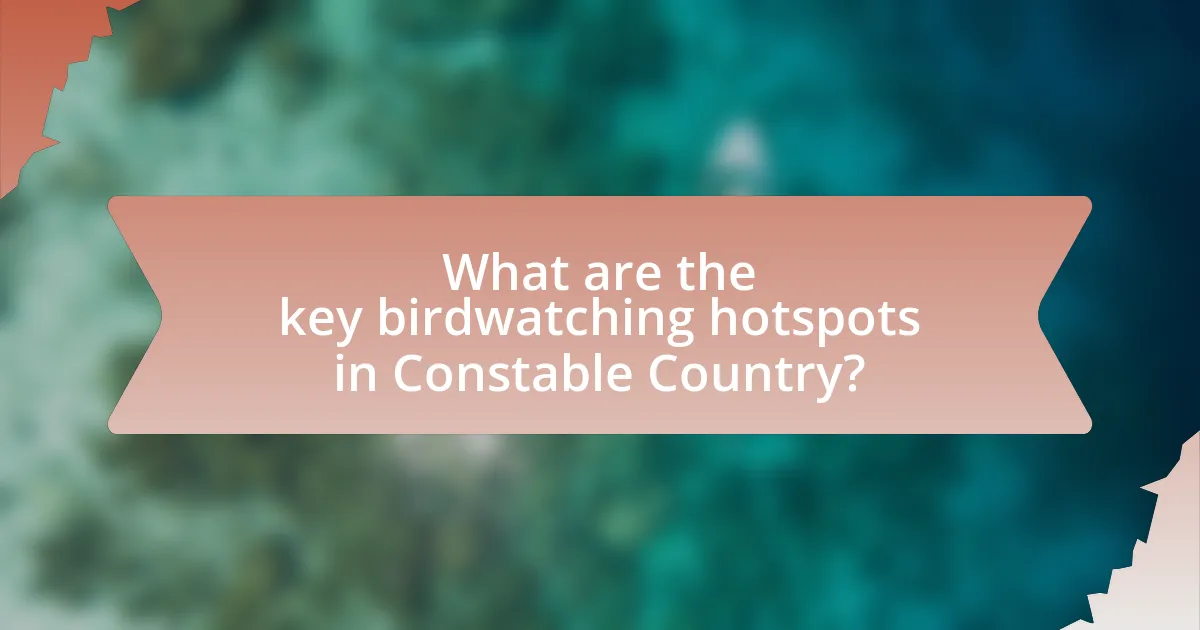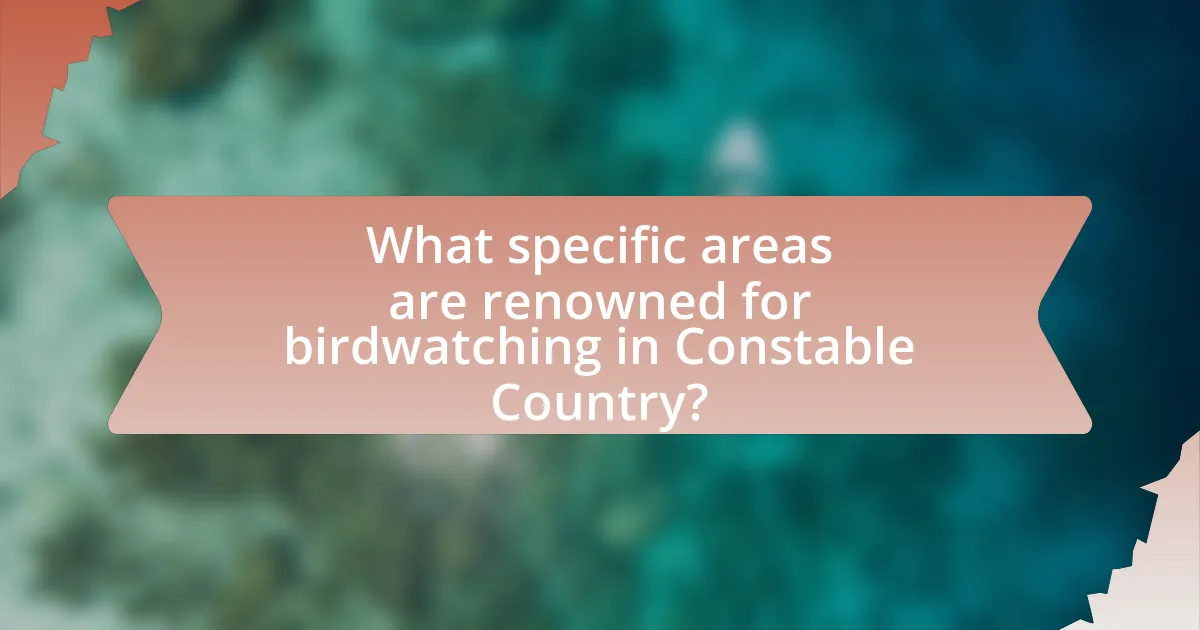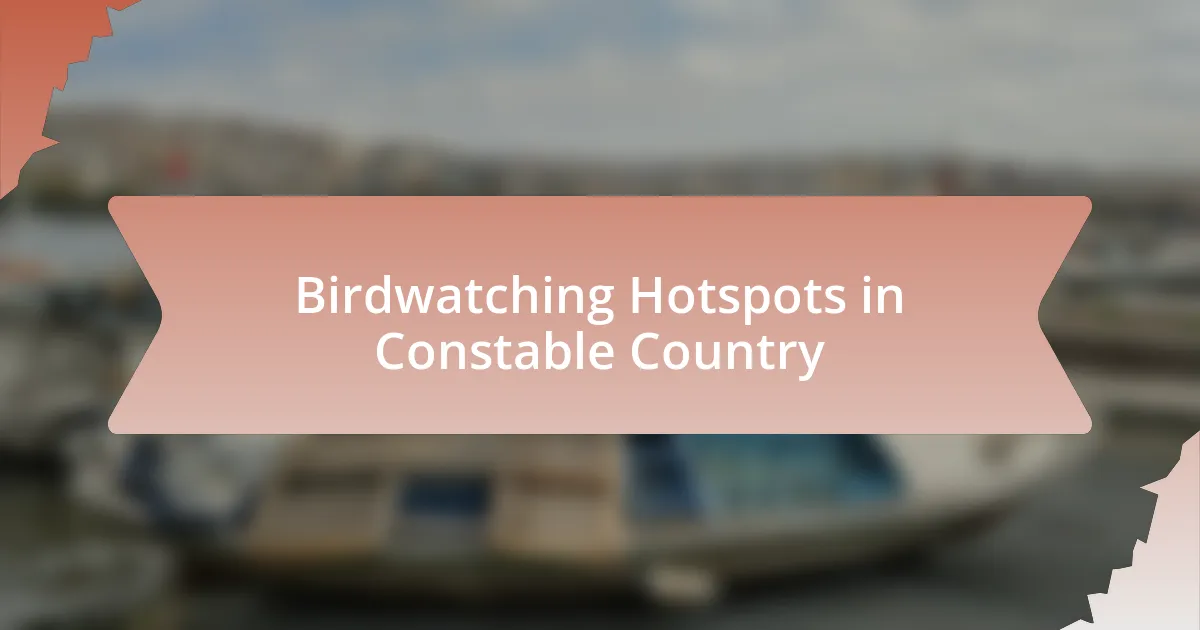Birdwatching hotspots in Constable Country include the Stour Valley, Flatford Marsh, and Dedham Vale, each offering unique habitats that attract a diverse range of bird species. The article outlines how these locations enhance birdwatching experiences through their rich ecosystems, seasonal dynamics, and notable bird populations, including species like the Eurasian Bittern and Marsh Harrier. It also discusses the geographical features, local climate influences, and conservation efforts that contribute to the area’s avian biodiversity. Additionally, the article provides practical tips for birdwatchers, including the best times to visit, essential equipment, and ethical considerations to minimize impact on wildlife.

What are the key birdwatching hotspots in Constable Country?
The key birdwatching hotspots in Constable Country include the Stour Valley, Flatford Marsh, and Dedham Vale. The Stour Valley is known for its diverse bird species, including waterfowl and waders, due to its rich wetland habitats. Flatford Marsh offers excellent opportunities to observe reedbed birds and migratory species, while Dedham Vale is recognized for its scenic landscapes that attract various songbirds and raptors. These locations are supported by local wildlife surveys and conservation efforts that highlight their importance for birdwatching.
How do these hotspots contribute to birdwatching experiences?
Birdwatching hotspots in Constable Country enhance birdwatching experiences by providing diverse habitats that attract a wide variety of bird species. These locations, such as wetlands, woodlands, and coastal areas, support different ecosystems, which in turn foster rich avian biodiversity. For instance, the presence of specific flora and water bodies in these hotspots creates ideal nesting and feeding grounds for both migratory and resident birds, making them prime spots for birdwatchers. Additionally, the concentration of bird species in these areas allows enthusiasts to observe and identify numerous birds in a single outing, significantly enriching their birdwatching experience.
What unique bird species can be observed at these locations?
Unique bird species that can be observed in Constable Country include the Eurasian Bittern, Marsh Harrier, and Avocet. The Eurasian Bittern, known for its distinctive booming call, can be found in reed beds, particularly in wetland areas. The Marsh Harrier, a large raptor, is often seen gliding over marshes and fields, hunting for small mammals and birds. The Avocet, with its striking black and white plumage and upturned bill, frequents shallow coastal waters and mudflats. These species are notable for their specific habitats and behaviors, making them key highlights for birdwatchers in this region.
How do seasonal changes affect birdwatching at these hotspots?
Seasonal changes significantly influence birdwatching at hotspots in Constable Country by altering bird migration patterns, breeding behaviors, and species diversity. During spring, migratory birds return, increasing the variety of species available for observation, while summer offers opportunities to witness nesting behaviors. In autumn, many birds migrate south, leading to a decline in local species but an influx of others preparing for migration. Winter often sees a decrease in bird activity, but certain species, such as wintering waterfowl, become more prominent. These seasonal dynamics are crucial for birdwatchers, as they dictate the best times to visit specific hotspots for optimal birdwatching experiences.
Why is Constable Country considered a prime location for birdwatching?
Constable Country is considered a prime location for birdwatching due to its diverse habitats, including wetlands, woodlands, and farmland, which support a wide variety of bird species. The area is home to over 200 species of birds, including notable species such as the Eurasian bittern and the barn owl, making it a significant site for both amateur and experienced birdwatchers. Additionally, the region’s rich biodiversity is enhanced by its conservation efforts, which aim to protect and restore natural habitats, further attracting migratory birds and enhancing the overall birdwatching experience.
What geographical features enhance birdwatching opportunities?
Wetlands, forests, and coastal areas enhance birdwatching opportunities by providing diverse habitats that attract various bird species. Wetlands serve as crucial feeding and nesting grounds for waterfowl and shorebirds, while forests offer shelter and food for songbirds and raptors. Coastal areas, with their rich marine ecosystems, draw migratory birds and seabirds. Studies indicate that regions with a mix of these geographical features support higher avian biodiversity, making them prime locations for birdwatching enthusiasts.
How does the local climate influence bird populations?
Local climate significantly influences bird populations by affecting their breeding, migration patterns, and food availability. For instance, warmer temperatures can lead to earlier breeding seasons, while extreme weather events can disrupt migration routes. Studies have shown that regions with stable climates support higher bird diversity, as consistent temperatures and precipitation patterns provide reliable habitats and food sources. In Constable Country, the local climate’s mild conditions and seasonal variations create diverse ecosystems that attract various bird species, enhancing birdwatching opportunities.

What specific areas are renowned for birdwatching in Constable Country?
The specific areas renowned for birdwatching in Constable Country include the Stour Valley, Flatford Marshes, and Dedham Vale. The Stour Valley is known for its diverse habitats, attracting various bird species such as herons and kingfishers. Flatford Marshes provide a rich wetland environment that supports waterfowl and migratory birds. Dedham Vale, with its mix of woodlands and open fields, is home to songbirds and raptors. These locations are recognized for their ecological significance and the variety of bird species they support, making them prime spots for birdwatching enthusiasts.
Which parks and reserves are must-visit for birdwatchers?
The must-visit parks and reserves for birdwatchers in Constable Country include the Dedham Vale Area of Outstanding Natural Beauty, Flatford Wildlife Garden, and the Stour Estuary. Dedham Vale offers diverse habitats that attract various bird species, including waterfowl and songbirds. Flatford Wildlife Garden features a range of environments, making it ideal for spotting garden birds and migratory species. The Stour Estuary is known for its rich birdlife, particularly waders and wildfowl, especially during migration seasons. These locations provide excellent opportunities for birdwatching due to their unique ecosystems and abundant avian populations.
What facilities and amenities do these parks offer to birdwatchers?
The parks in Constable Country offer various facilities and amenities specifically designed for birdwatchers, including designated birdwatching hides, observation platforms, and well-maintained trails. These features enhance the birdwatching experience by providing optimal viewing conditions and minimizing disturbance to wildlife. Additionally, many parks provide informational signage about local bird species and their habitats, which aids birdwatchers in identifying and understanding the avian life present. Some parks also offer guided birdwatching tours and educational programs, further enriching the experience for enthusiasts.
How accessible are these birdwatching locations for visitors?
The birdwatching locations in Constable Country are generally accessible for visitors, with many sites offering well-maintained paths and facilities. For instance, locations like the Stour Valley and Flatford Mill provide easy access via public transport and have designated parking areas. Additionally, the presence of visitor centers at some hotspots enhances accessibility by offering information and resources for birdwatchers.
What are the best times of year for birdwatching in Constable Country?
The best times of year for birdwatching in Constable Country are spring and autumn. During spring, migratory birds return, making it an ideal time to observe various species as they nest and breed. Autumn is also significant as many birds migrate south, providing opportunities to see large flocks. These seasonal changes enhance bird diversity and visibility, making both spring and autumn peak periods for birdwatching enthusiasts in the region.
How do migration patterns affect birdwatching opportunities?
Migration patterns significantly enhance birdwatching opportunities by determining the seasonal presence of various bird species in specific locations. During migration seasons, such as spring and fall, numerous species travel through regions like Constable Country, attracting birdwatchers eager to observe these transient populations. For instance, the arrival of migratory shorebirds and songbirds can create unique viewing experiences, as these birds often stop at key habitats to rest and feed. Studies indicate that areas with rich food sources and suitable nesting sites, such as wetlands and coastal regions, become hotspots for birdwatching during migration, thereby increasing the likelihood of spotting diverse species.
What events or festivals celebrate birdwatching in the region?
Birdwatching in Constable Country is celebrated through events such as the Suffolk Birdwatching Festival, which typically occurs in the spring and features guided walks, talks, and workshops focused on local bird species. Additionally, the RSPB (Royal Society for the Protection of Birds) organizes various events throughout the year, including birdwatching days at local reserves, which attract enthusiasts and families alike. These events provide opportunities for participants to engage with expert birdwatchers and learn about the region’s avian diversity.

What tips can enhance the birdwatching experience in Constable Country?
To enhance the birdwatching experience in Constable Country, birdwatchers should visit during early morning or late afternoon when birds are most active. This timing aligns with the natural behavior of many species, increasing the likelihood of sightings. Additionally, using binoculars with a magnification of at least 8x can improve visibility and detail, allowing for better identification of various bird species. Observing from concealed locations, such as behind trees or bushes, minimizes disturbance to the birds, making them more likely to engage in natural behaviors. Furthermore, familiarizing oneself with local bird species and their calls can significantly enhance the experience, as it allows birdwatchers to identify and locate birds more effectively. Constable Country is home to diverse habitats, including wetlands and woodlands, which support a variety of bird species, making it essential to explore different areas for a richer birdwatching experience.
How can birdwatchers prepare for their visits to hotspots?
Birdwatchers can prepare for their visits to hotspots by researching the specific locations, understanding the seasonal bird patterns, and gathering the necessary equipment. Researching locations involves checking local birdwatching guides or websites that provide information on the species present and the best times to visit. Understanding seasonal patterns is crucial, as certain species may only be present during specific times of the year, such as migratory seasons. Gathering equipment includes binoculars, field guides, and appropriate clothing for the weather conditions. These preparations enhance the birdwatching experience and increase the likelihood of observing a diverse range of species.
What equipment is essential for successful birdwatching?
Essential equipment for successful birdwatching includes binoculars, a field guide, and a notebook. Binoculars allow birdwatchers to observe birds from a distance, enhancing the viewing experience; models with a magnification of 8x to 10x are commonly recommended for clarity and ease of use. A field guide provides crucial information on bird species, helping enthusiasts identify and learn about the birds they encounter. A notebook is useful for recording observations, which can enhance the birdwatching experience by tracking sightings and behaviors. These tools collectively improve the effectiveness and enjoyment of birdwatching activities.
How can birdwatchers identify different species effectively?
Birdwatchers can identify different species effectively by utilizing field guides, apps, and binoculars to observe key characteristics such as size, color, and behavior. Field guides provide detailed descriptions and images of various species, while mobile apps often include audio calls and location data to assist in identification. Binoculars enhance the ability to observe birds from a distance, allowing for a clearer view of distinguishing features. Studies show that experienced birdwatchers can identify species with over 90% accuracy by focusing on these traits and utilizing technology to aid their observations.
What ethical considerations should birdwatchers keep in mind?
Birdwatchers should prioritize the well-being of birds and their habitats by adhering to ethical guidelines. These considerations include maintaining a respectful distance from nesting sites to avoid disturbing breeding activities, minimizing noise to prevent stress to wildlife, and avoiding the use of playback calls that can disrupt natural behaviors. Additionally, birdwatchers should stay on designated trails to protect sensitive ecosystems and refrain from collecting feathers or other natural artifacts. Research indicates that responsible birdwatching practices contribute to the conservation of avian species and their environments, promoting biodiversity and ecological balance.
How can birdwatchers minimize their impact on wildlife?
Birdwatchers can minimize their impact on wildlife by adhering to ethical birdwatching practices, such as maintaining a respectful distance from birds and their habitats. This approach helps prevent stress and disruption to wildlife, which is crucial for their well-being. Research indicates that close proximity to birds can lead to increased stress levels, affecting their feeding and breeding behaviors. Additionally, birdwatchers should avoid using playback calls, as this can disturb natural behaviors and lead to abandonment of nests. Following these guidelines not only protects wildlife but also enhances the birdwatching experience by promoting a sustainable interaction with nature.
What guidelines should be followed to ensure responsible birdwatching?
To ensure responsible birdwatching, individuals should adhere to guidelines that prioritize the well-being of birds and their habitats. These guidelines include maintaining a respectful distance from birds to avoid causing stress, using binoculars or spotting scopes instead of approaching too closely, and avoiding loud noises that may disturb wildlife. Additionally, birdwatchers should stay on designated paths to protect sensitive ecosystems and refrain from feeding birds, as this can disrupt their natural foraging behaviors. Following these practices helps preserve bird populations and their environments, contributing to sustainable birdwatching experiences.


